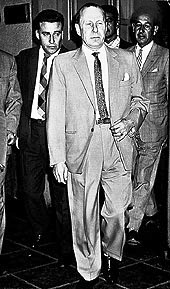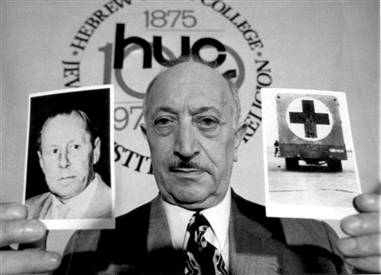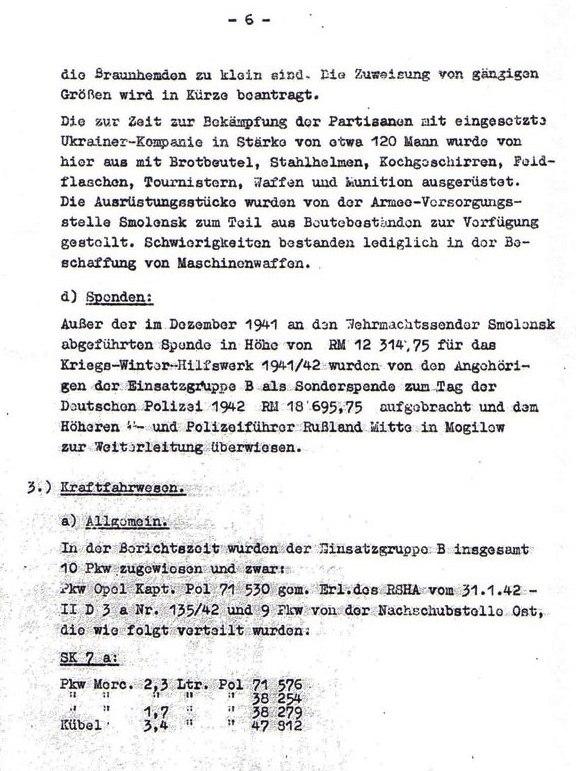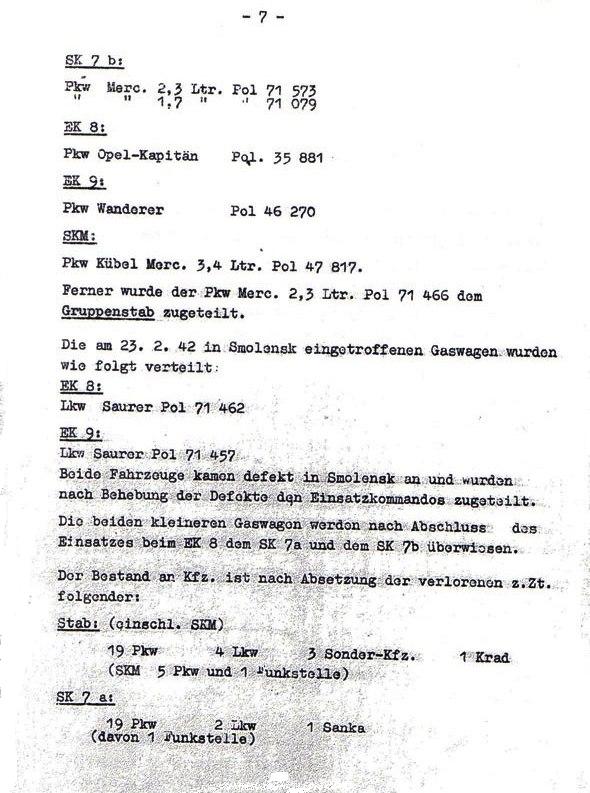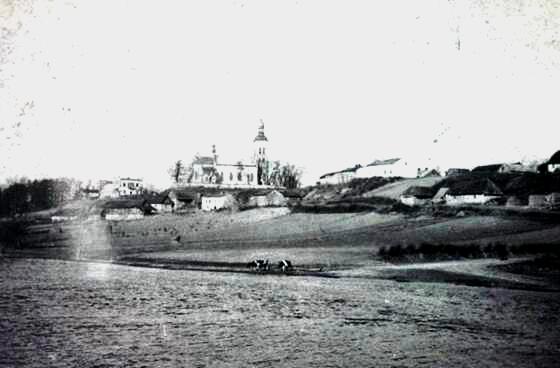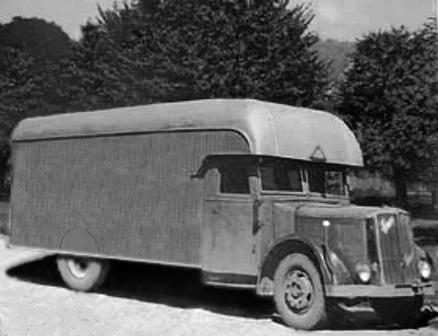Walther Rauff Letters to the Gas Van Expert Walther Rauff was born in 1906. He was a professional naval officer until a sordid divorce ended his career prospects which led to his resignation in December 1937. Rauff then worked in Reinhard Heydrich’s the Sicherheitsdienst (SD – Security Service) and was eventually made head of the section for technical affairs (Gruppe II D) of the Reichsicherheitshauptamt, he achieved the rank of SS- Obersturmbannfuhrer. In this role he was responsible in this role for the outfitting and supply of gas vans, which were used to mass murder Jew’s and Gypsies and Russian civilians in the Eastern territories. In late 1942 Rauff left Berlin to lead an SD Einsatzkommando in Tunis where he persecuted and killed Jews and in September 1943 he was transferred to Italy. First he went to Rome and later he became police chief of Milan and he surrendered to the American IV army on the 30 April 1945. After the capitulation Rauff was held in a prisoner-of-war camp near Rimini from which he escaped in December 1946, he was subsequently hidden in a monastery in Rome for eighteen months. Like a number of former Nazi war criminals Rauff sought refuge in South America, he eventually settled in Chile. In 1963 the Federal Republic of Germany sought his extradition from Chile but this was rejected by the Chilean Supreme Court as the charges were beyond the Chilean statute of limitations. The late “Nazi Hunter” Simon Wiesenthal sought for years to get Rauff extradited and stand trial for his war crimes and in 1984 a warrant was issued for his arrest and extradition and was to be taken to Santiago on the 16 May 1984, but Rauff had cheated justice, as he died of heart failure and the news reached the west on the 14 May 1984. Rauff was buried in Santiago Chile Letters to Walter Rauff Regarding Gassing Vans The following two letters from Dr August Becker and Willi Just shed some light on the use of Gassing Vans in Poland and Russia. (*Note photo's added to enhance the text of the letters) Letter from Dr August Becker to SS- Obersturmbannfuhrer Rauff. Report by Untersturmfuhrer Becker on the Operation of Gas Vans: May 16 1942 Field Post Office NO. 32704 B Nr 40/42 Kiev 16 May 1942 Top Secret To: SS –Obersturmbannfuhrer Rauff Berlin, Prinz- Albrecht –Str. 8 The overhauling of vans by groups D and C is finished. While the vans of the first series can also be put into action if the weather is not too bad, the vans of the second series (Saurer) stop completely in wet weather. For instance even if it has been raining for half an hour, the van cannot be used because it simply skids away. It can only be used in absolutely dry weather. The question then arises whether the van can only be used standing at the place of execution. First the van has to be brought to that place, which can only be possible in fine weather. The place of execution is usually 10-15 km away from the highways and is difficult to access because of its location: in damp or wet weather it is not accessible at all. If the persons to be executed are driven or led to that place, then they realise immediately what is going on and get restless, which should be avoided at all costs. There is only one way left, to load them at the collecting point and to drive them out there. I ordered the vans of group D to be camouflaged as house-trailers by putting one set of window shutters on each side of the small van and two on each side of the larger vans, such as one often sees on farm-houses in the country. The vans became so well-known that not only the authorities, but also the civilian population allude to it as the “death van” as soon as one of these vehicles appeared. In my opinion even with camouflage the van cannot be kept secret for any length of time. The Saurer van which I transported from Simferopol to Taganrog suffered damage to the brakes on the way. The Security Command (SK) in Mariupol found the cuff of the combined oil-air brake broken at several points. By persuading and bribing the H.K.P. we managed to have a form machined, on which the cuffs were cast. When I came to Stalino and Gorlowka a few days later, the drivers of the vans complained about the same faults. After having talked to the commandants of those commands I went once more to Mariupol to have some more cuffs made for those vans too. As agreed two cuffs will be made for each van, six cuffs will stay in Mariupol as replacements for group D and six cuffs will be sent to SS-Untersturmfuhrer Ernst in Kiev for the vans of group C. The cuffs for the groups B and A could be made available from Berlin, because transport from Mariupol to the north would be too complicated and would take too long. Smaller damages on the cars will be repaired by experts of the commands, that is, of course, the groups in their own shops. Because of the rough terrain and the indescribable road and highway conditions the caulkings and rivets loosen in the course of time. I was asked if in such cases the vans should be brought to Berlin for repair. Transportation to Berlin would be much too expensive and would demand too much fuel. In order to save those expenses I ordered them to have smaller leaks soldered and if that should no longer be possible, to notify Berlin immediately by radio, that Pol. Nr …. is out of order. Besides that I ordered that during the gassing all the men were to be kept as far away from the vans as possible, so they should not suffer damage to their health by any escaping gases. I should like to take this opportunity to bring the following to your attention: several commands have had the unloading after the application of gas done by their own men. I brought to the attention of the commanders of those S.K. concerned the immense psychological injuries and damages to their health which that work can have for those men, even if not immediately, at least later on. The men complained to me about headaches which appeared after each unloading. Nevertheless they don’t want to change the orders, because they are afraid prisoners called for that work, could use an opportune moment to escape. To protect the men from these damages, I request orders be issued accordingly. The gassing usually is not undertaken correctly. In order to come to an end as fast as possible, the driver presses the accelerator to the fullest extent. By doing that the persons to be executed suffer death from suffocation and not death by dozing off as was planned. My instructions now have proved that by correct adjustment of the levers death comes faster and the prisoners fall asleep peacefully. Distorted faces and excretions, such as could be seen before, are no longer to be seen. Today I shall continue my journey to group B, where I can be reached with further news. Signed: Dr Becker SS Untersturmfuhrer |
The second letter is from Willi Just to Walter Rauff providing greater insight into the activities of the gas van mass murder programme: Berlin 5 June 1942 Only Copy Top Secret 1. Note: Conc: Technical adjustments to special vans at present in service and to those that are in production. Since December 1941, ninety- seven thousand have been processed, using three vans, without any defects showing up in the vehicles. The explosion that we know took place at Kulmhof is to be considered an isolated case. The cause can be attributed to improper operation. In order to avoid such incidents, special instructions have been addressed to the services concerned. Safety has been increased considerably as a result of these instructions. Previous experience has shown that the following adjustments would be useful. 1) In order to facilitate the rapid distribution of CO, as well as to avoid a build-up of pressure, two slots, ten by one centimetres, will be bored at the top of the rear wall. The excess pressure would be controlled by an easily adjustable hinged metal valve on the outside of the vents. 2) The normal capacity of the vans is nine to ten per square metre (= 10.8 sq.ft) The capacity of the larger special Saurer vans is not so great. The problem is not one of overloading but of off-road manoeuvrability on all terrains, which is severely diminished in this van. It would appear that a reduction in the cargo area is necessary. This can be achieved by shortening the compartment by about one metre. The problem cannot be solved by merely reducing the number of subjects treated, as has been done so far. For in this case a longer running time is required, as the empty space also needs to be filled with CO. On the contrary, were the cargo area smaller, but fully occupied, the operation would take considerably less time, because there would be no empty space. 3) The pipe that connects the exhaust to the van tends to rust, because it is eaten away from the inside by liquids that flow into it. To avoid this, the nozzle should be so arranged as to point downward. The liquids will thus be prevented from flowing into the pipe. 4) To facilitate the cleaning of the vehicle, an opening will be made in the floor to allow for drainage. It will be closed by a watertight cover about twenty to thirty centimetres in diameter, fitted with an elbow siphon that will allow for the thin liquids. The upper part of the elbow pipe will be fitted with a sieve to avoid obstruction. Thicker dirt can be removed through the large drainage hole when the vehicle is cleaned. The floor of the vehicle can be tipped slightly. In this way all the liquids can be made to flow toward the centre and be prevented from entering the pipes. 5) The observation windows that have been installed up to now could be eliminated, as they are hardly ever used. Considerable time will be saved in the production of the new vans by avoiding the difficult fitting of the window and its airtight lock. 6) Greater protection is needed for the lighting system. The grille should cover the lamps high enough up to make it impossible to break the bulb. It seems these lamps are hardly ever turned on, so the users have suggested that they can be done away with. Experience shows, however, that when the back door is closed and it gets dark inside, the load pushes hard against the door. The reason for this is that when it becomes dark inside the load rushes toward what little light is left. This hampers the locking of the door. It has also been noticed that the noise provoked by the locking of the door is linked to the fear aroused by the darkness. It is therefore expedient to keep the lights on before the operation and during the first few minutes of its duration. Lighting is often useful for night work and for the cleaning of the interior of the van. 7) To facilitate the rapid unloading of the vehicles, a removable grid is to be placed on the floor. It will slide on rollers on a U-shaped rail. It will be removed and put in position by means of a small winch placed under the vehicle. The firm charged with the alterations has stated that it is not able to continue for the moment, due to a lack of staff and materials. Another firm will have to be found. The technical changes planned for the vehicles already in operation will be carried out when and as major repairs to these vehicles prove necessary. The alterations in the ten Saurer vehicles already ordered will be carried out as far as possible. The manufacturer made it clear in a meeting that structural alternations, with the exception of minor ones, cannot be carried out for the moment. An attempt must therefore be made to find another firm that can carry out, on at least one of these ten vehicles, the alterations and adjustments that experience has proved to be necessary. I suggest that the firm in Hohenmauth be charged with the execution. Due to present circumstances, we shall have to expect a later date of completion for this vehicle. It will then not only be kept available as a model but also be used as a reserve vehicle. Once it has been tested, the other vans will be withdrawn from service and will undergo the same alterations. II To Gruppenleiter IID SS- Obersturmbannfuhrer Rauff for examination and decision. |
The funeral of Walter Rauff At the Santiago funeral of SS Colonel Walter Rauff, in May 1984, Chilean diplomat Miguel Serrano, gave the Hitler salute. He convened a rally, in Santiago on 5 September 1993, in honor of Rudolf Hess and in memory of the Chilean Nazi martyrs of 1938. He maintains correspondence with neo-Nazi leaders, such as Matt Koehl. An interview with him was featured in the literature of the Black Order.
Sources: Bundesarchiv Wiener Library Nazism: A History in Documents and Eyewitness Accounts 1919 -1945, published by Schocken Books New York 1988. Justice not Vengeance Simon Wiesenthal published by Weidenfeld and Nicolson London 1989. Miguel Serrano Archive NARA PRO Copyright: CW & CL H.E.A.R.T 2009 |
